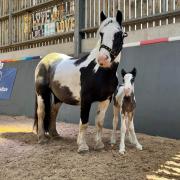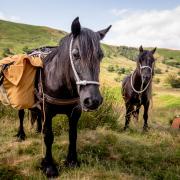Parbold-born Ian Lawson has covered windswept fells and rugged mountains to record the lives of Lakeland’s iconic sheep and their farmers

Herdwicks have been features of the Lakeland fells for generations but Ian Lawson is concerned for their future and he knows a thing or two about the iconic sheep, having spent much of the last six years chronicling their lives.
Ian is worried that unless the industry is safeguarded the breed could become a page in the region’s history books. ‘The Lake District looks the way it does largely because of sheep farming and people love the look of it, without necessarily knowing the reason,’ he said. ‘I think visitors to the Lake District would hate to see the industry go, but the odds are stacked against Herdwick sheep farming and once it’s gone it really has gone. You can’t just throw some sheep on a fell, these are incredible animals.’
Ian’s love of the Herdwick grew out of his painstaking project to record every aspect of the harsh existence on the fells and farms of the Lake District. His work, which has resulted in a stunning book and an exhibition at the Rheged centre near Penrith, was inspired by a chat with a farmer in Borrowdale.
‘Six of the farms I have worked on were owned by Beatrix Potter and she stated in her will that she only wanted Herdwicks on her farms after her death,’ he said. ‘I think she would be very upset at the way the landscape and industry have been eroded.’

Ian moved to the Lake District eight years ago, but was brought up in Parbold in the 1960s and spent much of his time in the fields around his childhood home where he developed a passion for nature and birdwatching.
After seven years at boarding school in Scotland he returned to sixth form college in Orrell where he hosted a Northern Soul event with some friends in order to raise the money for his first camera. ‘It was a Chinon and it was state-of-the-art at the time,’ he said.
‘I enjoyed taking pictures, mainly landscapes, sending the film off to the chemist and seeing the results when they came back. I got more serious and thought the best thing to do would be to get a degree, I thought having letters after my name would help me get a job.
‘I was not very academic, I spent a lot of my time outdoors and I have always loved everything to do with nature. I had three sisters who all went into dentistry but I was the black sheep of the family. I used to want to be a vet until I realised you had to be very smart, and I knew I wasn’t.’

He completed a degree in photography at the then Manchester Polytechnic he hoped to work as a landscape photographer but fell into a job as an architectural photographer where he spent 30 years.
‘I spent 30 years working in a job I didn’t set out to do but as I got older I would make more time for myself – all I ever wanted was to be out there in the landscapes and I promised myself that when I was 50 I would go out into the landscape I love and the places I love and create artworks for people to buy,’ Ian said.
He visited the Outer Hebrides as he worked to build a portfolio of landscapes and was smitten with the place, making several trips a year. On one visit to the Isle of Lewis he happened upon a tweed weaving shed where he became entranced with the story of tweed and embarked upon a punishing eight years tracing the connections between the landscape, the people and the cloth.
‘There came a point where the landscape wasn’t enough for what I wanted to say. I wanted to explore the relationships between people and the landscapes, people who represented what the Hebrides are all about.

‘The noise, smell and colours of that loom shed blew me away. There is a relationship between the landscape and the tweeds and I ended up producing a book but then spent three horrendous years with people telling me my ideas were too ambitious so I decided to self publish, it was the only way I could guarantee I was representing the Outer Hebrides in the way I wanted to. There’s a real emotional investment in my work.
‘It was eight years of work and it encapsulates everything about the place. I was driven by an emotional attraction and self-publishing was a gamble but the first two editions sold out within seven months and that gave me the confidence to become the photographer I am today.’
And after a chance meeting in the Lake District he was inspired to begin another major project. ‘I was in Borrowdale photographing a packhorse bridge when three Herdwick sheep came and stopped on the bridge,’ Ian said. ‘Then the shepherd came with his dogs and we started chatting and that was it – I was off hunting shepherds.
‘I went to shepherds’ meets three or four times a year and got to know them and their way of life. I have bought books written in the 40s, 50s and 60s and what they describe is what I experienced and that really inspired me to record what I could of what’s going on. I didn’t want it to be my story, I wanted it to be the story of the people who inspired me.

‘Shepherds have gone on doing what they do in spite of changes in government and I hold shepherds very dear. There are some real characters among the Herdwick farmers and for me to be able to work with them and gain their confidence is the ultimate thing.
‘The biggest single inspiration for me was the gathers, epic events where farmers and their dogs would bring the sheep down from a huge area of the mountains – they were like military operations. The skill of the shepherds and their dogs is incredible.’
His admiration for the farmers is evident in the 250 spectacular photographs which make up his latest book, Herdwick: A Portrait of Lakeland, some of which you can see on these pages.
‘I wanted to create a classic book, something that would stand the test of time like the Herdwicks have done,’ said Ian, a father of two who now lives at Bampton in the Lowther Valley. ‘Tweed and Herdwicks are ten year projects and I will continue updating them to get the message out there.’
The Herdwick exhibition charts a year in the life of the Herdwicks, from spring to spring, and will run at Rheged until April 19. It will also feature 16 art pieces inspired by Ian’s photographs and made by members of the Wool Clip, a Caldbeck based group who spin and knit with Herdwick wool.
Join the herd
Herdwick: A Portrait of Lakeland is open until Sunday April 19th. It is open every day from 10.30am-4.30pm and admission is free. For more information go to rheged.com, call 01768 860033 or follow @rhegedcentre on Twitter.
The book of the same name will be launched at the exhibition. It features over 250 large-format photographs over 430 pages, bound in hardback and printed on thick archival paper. The photographs are interwoven with a 12,000 word story of the Herdwick year.
Ian’s next book, about shepherdess Alison O’Neill will be out later this year. For more information about him and his work, go to ianlawson.c



























